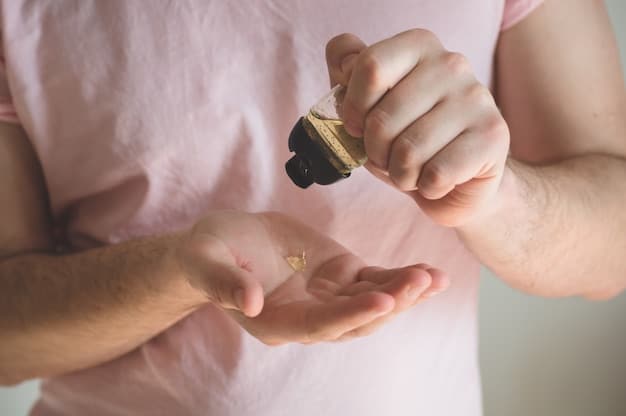Skincare Routine Order: Maximize Results for Your Skin

The correct skincare routine order is essential for ensuring each product absorbs properly and delivers its intended benefits, starting with cleansing and ending with protection.
Ever wondered if you’re applying your skincare products in the right order? The skincare routine order can significantly impact the effectiveness of each product, ensuring your skin receives maximum benefits. Applying products in the correct sequence helps ingredients penetrate properly, addressing your skin’s needs in the most efficient way. Let’s explore the ideal order to achieve glowing, healthy skin.
Understanding the Importance of Skincare Routine Order
The order in which you apply your skincare products isn’t just a suggestion—it’s a critical factor in how well they work. Think of your skincare routine as a carefully orchestrated symphony, where each product plays a vital role, and its timing matters. Proper layering ensures that each ingredient can penetrate the skin effectively, maximizing its benefits.
Applying products in the wrong order can hinder absorption, rendering some ingredients ineffective. For example, a heavy moisturizer applied before a lightweight serum can prevent the serum from reaching the skin, wasting its potential. Let’s delve into why sequence matters in your skincare journey.
Why the Order Matters
The sequence in which you apply skincare products significantly impacts their effectiveness. Each product is formulated with a specific molecular structure and function that relies on proper layering for optimal penetration and absorption.
- Absorption Rates: Lighter products, like serums and toners, should be applied first to allow them to absorb into the skin without being blocked by heavier creams.
- Effectiveness of Ingredients: Certain ingredients can enhance or diminish the impact of others. For instance, applying an emollient-rich moisturizer before an active ingredient like retinol can buffer its effects, reducing potential irritation but also decreasing its efficacy.
- Prevention of Product Pilling: Applying products in the wrong order can sometimes cause them to pill or roll off the skin, meaning they are not being absorbed correctly and can lead to clogged pores.
In conclusion, the skincare routine order is not just a minor detail, but a critical step to fully harness the power of your skincare arsenal. Get it right, and you set the stage for healthier, more radiant skin.

Step-by-Step Guide to Your Morning Skincare Routine
Your morning skincare routine is all about protection and hydration. It sets the stage for your skin to face the day’s challenges, from UV rays to environmental pollutants. Here’s a straightforward guide to kickstart your day with a refreshed and protected complexion.
Start your day by following a set order that begins with gentle cleansing and ends with vital sun protection, each step building upon the last to keep your skin healthy and radiant. Here’s how to achieve the perfect morning routine.
Step 1: Cleanser
Start your day with a gentle cleanser to remove any impurities or excess oil that accumulated overnight. Choose a cleanser suited to your skin type to avoid stripping away essential moisture.
Step 2: Toner
Toners help balance your skin’s pH levels and prep it to better absorb subsequent products. Look for alcohol-free options to avoid dryness. Apply toner with a cotton pad or by patting it gently into your skin.
Step 3: Serum
Serums are concentrated treatments targeting specific skin concerns such as fine lines, dark spots, or hydration. In the morning, focus on antioxidants like Vitamin C to protect against environmental damage.
Step 4: Moisturizer
Even if you have oily skin, moisturizing is essential. Choose a lightweight, non-comedogenic moisturizer to hydrate without clogging pores. This step locks in the serum and keeps your skin supple throughout the day.
Step 5: Sunscreen
Sunscreen is the most crucial step in your morning routine. Apply a broad-spectrum sunscreen with an SPF of 30 or higher to protect your skin from harmful UV rays. This helps prevent premature aging and reduces the risk of skin cancer.
Mastering your morning skincare routine involves not just the right products, but also the right sequence. By following these steps, you are setting your skin up for success, ensuring it stays protected, hydrated, and radiant throughout the day.
Establishing Your Nighttime Skincare Routine
Your nighttime skincare routine is essential for repair and rejuvenation. While you sleep, your skin works to recover from the day’s exposure to environmental stressors. Therefore, your evening routine should focus on thorough cleansing, treatment, and deep hydration.
By concentrating on repair and nourishment during the night, you support your skin’s natural recovery processes. This is the time to use products that promote cell turnover and deeply moisturize. Let’s explore the must-do steps for a great nighttime routine.
Step 1: Makeup Removal
Before anything else, remove all traces of makeup using a gentle makeup remover. Makeup left on overnight can clog pores and lead to breakouts.
Step 2: Double Cleanse
Follow up with a cleanser to remove any remaining impurities and oils. This double-cleansing method ensures your skin is thoroughly clean and ready for treatment products.
Step 3: Exfoliate (1-2 Times Per Week)
Exfoliation removes dead skin cells, allowing for better absorption of other products and revealing brighter skin. Choose either a chemical exfoliant (like AHAs or BHAs) or a gentle physical scrub, but avoid over-exfoliating, which can irritate the skin.
Step 4: Toner
Just like in the morning, toner helps balance your skin’s pH levels. Choose a hydrating toner that prepares your skin for the next steps.
Step 5: Serum
Nighttime is ideal for using treatment-focused serums with ingredients like retinol or peptides, which promote cell turnover and collagen production. Apply these before your moisturizer to ensure they penetrate the skin effectively.
Step 6: Eye Cream
The skin around your eyes is delicate and prone to fine lines and wrinkles. Use a nourishing eye cream to hydrate and address concerns like dark circles or puffiness.
Step 7: Moisturizer
End your nighttime routine with a rich moisturizer to deeply hydrate and lock in all the products you’ve applied. A thicker cream can help repair and replenish your skin overnight.
A carefully constructed nighttime routine is the cornerstone of healthy, rejuvenated skin. By following these steps consistently, you support your skin’s natural repair processes, ensuring you wake up with a refreshed and revitalized complexion.

The Role of Serums and Treatments in Your Routine
Serums and treatments are the workhorses of any effective skincare routine order. These potent formulations contain concentrated active ingredients designed to target specific skin concerns, from aging and pigmentation to acne and hydration. Understanding how to incorporate them correctly can significantly enhance your skin’s health and appearance.
These targeted treatments are meant to address specific needs, deliver intense hydration, and combat signs of aging. Knowing when and how to use serums and treatments can transform your skin. Let’s explore the best ways to integrate these potent products.
Understanding Serums
Serums are lightweight, fast-absorbing liquids packed with active ingredients. They are designed to penetrate deeply into the skin to deliver targeted results. Different serums address various concerns, so it’s essential to choose the right one for your skin type and issues.
- Hydrating Serums: Contain ingredients like hyaluronic acid to draw moisture into the skin.
- Antioxidant Serums: Feature ingredients like Vitamin C and E to protect against free radical damage.
- Brightening Serums: Include ingredients like niacinamide or licorice root extract to reduce dark spots and even out skin tone.
When to Apply Serums
Serums should be applied after cleansing and toning, but before moisturizing. This ensures that the active ingredients can penetrate the skin without being blocked by heavier creams. Pat the serum gently onto your face and allow it to absorb for a few minutes before proceeding with the next step.
Treatment Products: Retinoids and Exfoliants
Treatment products, such as retinoids and exfoliants, have a transformative effect on your skin when used correctly. They improve skin texture, reduce fine lines, and combat acne. However, they can also be irritating, so it’s crucial to introduce them gradually.
How to Use Retinoids
Retinoids, like retinol and tretinoin, promote cell turnover and collagen production. Start by using them once or twice a week at night, gradually increasing frequency as your skin tolerates it. Always apply retinoids to dry skin to minimize irritation and avoid using them on the same night as chemical exfoliants.
Exfoliants for Skin Renewal
Exfoliants remove dead skin cells, revealing smoother, brighter skin. Chemical exfoliants, such as AHAs (alpha-hydroxy acids) and BHAs (beta-hydroxy acids), are effective but can also be irritating. Start with a low concentration and use them sparingly, following up with a hydrating moisturizer.
Integrating serums and treatments into your skincare routine order can make a significant difference in your skin’s overall health and appearance. By choosing the right products and applying them correctly, you can effectively address specific concerns and achieve a radiant, youthful complexion.
Layering Products Correctly: Thin to Thick Rule
One of the golden rules in skincare is to apply products from thinnest to thickest consistency. This ensures that each product can penetrate the skin properly, delivering its intended benefits. Layering products in the wrong order can hinder absorption and reduce effectiveness.
Layering skincare products properly is about maximizing absorption and efficacy. By understanding this “thin to thick” approach, you can ensure that each product performs its intended function. Let’s get into the details.
Why Thin to Thick Matters
The “thin to thick” rule is based on the principle that lighter, more watery products should go on first to penetrate the skin easily. Heavier creams and oils create a barrier that can prevent thinner products from being absorbed if applied beforehand.
The Ideal Product Order
- Water-Based Products: Start with the most lightweight, water-based products like toners and essences.
- Serums: Apply serums next, as they are concentrated treatments designed to penetrate deeply.
- Gels: Follow with gel-based products, which are slightly thicker than serums but still relatively lightweight.
- Creams: Apply creams next, which provide hydration and create a protective barrier on the skin.
- Oils: End with oils, which have larger molecules and are designed to seal in all the products underneath.
Exceptions to the Rule
While the “thin to thick” rule is a helpful guideline, there are a few exceptions. For example, some experts recommend applying facial oils before moisturizers if your skin is very dry, as the oil can help the moisturizer absorb better. Additionally, sunscreen should always be applied as the last step in your morning routine, regardless of its consistency, to ensure it forms a protective barrier on the skin.
Maximizing Absorption
To maximize absorption, allow each product to absorb fully before applying the next. This typically takes a few minutes. Gently patting or massaging the product into your skin can also enhance absorption.
Adhering to the “thin to thick” rule is critical for optimizing the effectiveness of your skincare routine order. By ensuring that each product can penetrate and work as intended, you are setting the stage for healthier, more radiant skin.
Common Mistakes in Skincare Routine Order to Avoid
Even with the best products, mistakes in your skincare routine order can undermine your efforts. Avoiding these common pitfalls ensures that your skin receives the full benefits of your carefully selected products.
There are several common mistakes that can reduce the efficacy of your regimen. From applying products in the wrong sequence to skipping steps, these errors can compromise your skin’s health. Let’s explore these mistakes and learn how to avoid them.
Incorrect Layering
The most common mistake is applying products in the wrong order, especially mixing up the “thin to thick” rule. This can prevent proper absorption and reduce the effectiveness of key ingredients.
Skipping Essential Steps
Skipping steps, such as sunscreen in the morning or makeup removal at night, can have significant negative effects on your skin’s health and appearance. Sunscreen protects against aging and skin cancer, while makeup removal prevents clogged pores and breakouts.
Over-Exfoliating
Exfoliating too frequently or using harsh exfoliants can strip your skin of its natural oils and lead to irritation, redness, and dryness.
Using Incompatible Ingredients Together
Combining certain ingredients, such as retinoids and AHAs/BHAs, can cause irritation and damage your skin. It’s essential to understand which ingredients work well together and which should be used separately.
Not Allowing Products to Absorb
Rushing through your routine and not allowing products to absorb fully can prevent them from working effectively. Give each product a few minutes to penetrate the skin before applying the next.
Ignoring Your Skin Type
Using products that are not suited to your skin type can lead to various issues, such as breakouts, dryness, or oiliness. Choose products specifically formulated for your skin type and adjust your routine as needed.
Avoiding these common mistakes in your skincare routine order ensures that your skin receives the maximum benefits from your products. By following the correct sequence and understanding the needs of your skin, you can achieve a healthy, radiant complexion.
| Key Point | Brief Description |
|---|---|
| ✅ Cleanse First | Removes impurities and prepares skin. |
| 🧴 Apply Thin to Thick | Ensures proper absorption of each product. |
| ☀️ Sunscreen Last (AM) | Protects skin from UV damage. |
| 🌙 Nighttime Repair | Focus on treatments like retinoids. |
Frequently Asked Questions
▼
The right order ensures each product absorbs properly and works effectively. Applying thinner products before thicker ones, for example, helps ingredients penetrate the skin.
▼
A basic routine should include cleanser, toner, serum, moisturizer, and sunscreen (in the morning). At night, skip sunscreen and focus on repairing treatments.
▼
Yes, but apply them from thinnest to thickest, and consider using different serums at separate times (e.g., antioxidant serum in the morning, hydrating serum at night).
▼
Exfoliate 1-2 times per week to avoid irritation. Over-exfoliating can strip your skin of natural oils and lead to dryness or redness.
▼
Yes, even oily skin needs hydration. Choose a lightweight, non-comedogenic moisturizer to keep your skin balanced without clogging pores.
Conclusion
Mastering the skincare routine order is crucial for maximizing the effectiveness of your products and achieving a healthy, radiant complexion. By following the guidelines outlined in this guide, you can ensure that each product penetrates properly, delivering its intended benefits. Consistency and attention to detail are key to unlocking your skin’s full potential.





